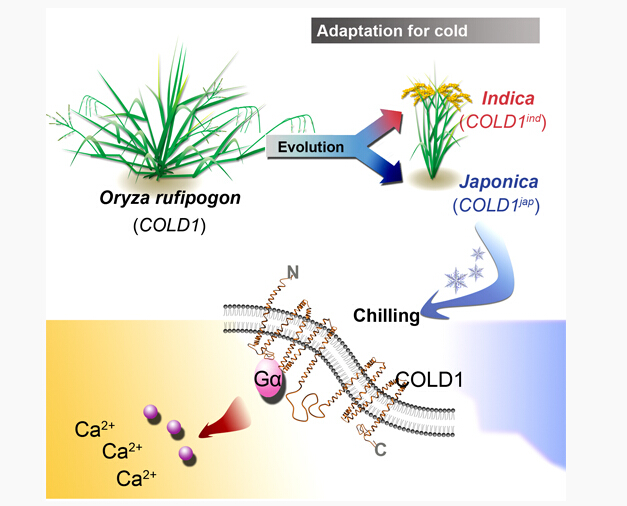Rice is originally domesticated in tropical and subtropical areas and is sensitive to cold stress. Extreme temperature thus represents a key factor limiting global rice plant distribution. Artificial selection and domestication expand typical japonica cultivars into northern areas with lower yearly temperatures, which generally exhibit stronger chilling tolerance than indica cultivars. However, it is unknown how the signaling pathway in response to chilling evolved. Prof. Kang Chong and his team at the Institute of Botany, CAS, in collaboration with scientists in China National Rice Research Institute, CAAS, have discovered a novel chilling-adaptive QTL in COLD1 gene that confers cold tolerance in japonica rice. Over-expression of COLD1japsignificantly enhances chilling tolerance, whereas rice with deficiency or down-regulation of COLD1jap are sensitive to chilling. COLD1 encodes a G-protein regulator localized on plasma membrane and endoplasmic reticulum. COLD1 interacts with the G-protein α subunit (RGA1) to activate the Ca2+ channel leading to Ca2+influx into cytoplasm for sensing chilling.
The work established a novel mechanism for cold tolerance in rice.COLD1 alleles can potentially be used for improving chilling tolerance in rice via molecular assisted breeding. This work is published in the latest issue of Cell on 26 February, 2015 (http://dx.doi.org/10.1016/j.cell.2015.01.046), Yun Ma, Xiaoyan Dai, Yunyuan Xu and Wei Luo in Professor Kang Chong’s lab are major contributors of this paper. The work was supported by the Major State Basic Research Program of China (973), NSFC and CAS Innovation Systems of Designer Breeding by Molecular Modules.

Figure. The mechanism of rice artificial domestication selection COLD1 sensing low temperature. During the process of rice domestication, a SNP in COLD1, SNP2, originated from Chinese Oryza rufipogon is selected, which determines the different sensitivity of sensing low temperature between the japonica and indica rice and is responsible for the ability of COLDjap/ind to regulate GTPase activity of RGA1.
Rice is originally domesticated in tropical and subtropical areas and is sensitive to cold stress. Extreme temperature thus represents a key factor limiting global rice plant distribution. Artificial selection and domestication expand typical japonica cultivars into northern areas with lower yearly temperatures, which generally exhibit stronger chilling tolerance than indica cultivars. However, it is unknown how the signaling pathway in response to chilling evolved. Prof. Kang Chong and his team at the Institute of Botany, CAS, in collaboration with scientists in China National Rice Research Institute, CAAS, have discovered a novel chilling-adaptive QTL in COLD1 gene that confers cold tolerance in japonica rice. Over-expression of COLD1japsignificantly enhances chilling tolerance, whereas rice with deficiency or down-regulation of COLD1jap are sensitive to chilling. COLD1 encodes a G-protein regulator localized on plasma membrane and endoplasmic reticulum. COLD1 interacts with the G-protein α subunit (RGA1) to activate the Ca2+ channel leading to Ca2+influx into cytoplasm for sensing chilling.
The work established a novel mechanism for cold tolerance in rice.COLD1 alleles can potentially be used for improving chilling tolerance in rice via molecular assisted breeding. This work is published in the latest issue of Cell on 26 February, 2015 (http://dx.doi.org/10.1016/j.cell.2015.01.046), Yun Ma, Xiaoyan Dai, Yunyuan Xu and Wei Luo in Professor Kang Chong’s lab are major contributors of this paper. The work was supported by the Major State Basic Research Program of China (973), NSFC and CAS Innovation Systems of Designer Breeding by Molecular Modules.

Figure. The mechanism of rice artificial domestication selection COLD1 sensing low temperature. During the process of rice domestication, a SNP in COLD1, SNP2, originated from Chinese Oryza rufipogon is selected, which determines the different sensitivity of sensing low temperature between the japonica and indica rice and is responsible for the ability of COLDjap/ind to regulate GTPase activity of RGA1.
